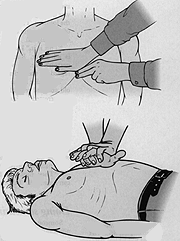cardiac massage

Cardiac massage is an emergency procedure carried out, in conjunction with mouth-to-mouth resuscitation, on someone who has collapsed with cardiac arrest.
When the heart stops completely, the patient loses respiration, the pulse ceases in all the major blood vessels, and the pupils become dilated. In such a situation, mouth-to-mouth artificial respiration should be given along with external cardiac massage. These are measures which can be taken prior to arrival of services.
To give cardiac massage, the patient must be placed on a firm surface, such as the floor. If the rescuer is alone, the patient's lungs should be filled with three or four rapid mouth-to-mouth respirations before attempting to massage. Ideally, both artificial respiration and massage are performed at the same time by two rescuers. There is no need to coordinate the two activities between the rescuers. In massage, the rescuer puts one hand across the lower sternum (breast-bone) of the patient. The other hand is placed on top to make a right angle. The full weight of the rescuer is applied rhythmically through the heel of the hands, at about one thrust per second. The sternum moves in about 4 or 5 centimeters (1.5 to 2 inches), compressing the heart. When pressure is lifted, blood reenters the heart. If the rescuer is alone, several rapid mouth-to-mouth respirations should be given to the patient every 30 seconds.
If massage is successful, gasping and some movement may occur and the pupils will constrict. If no signs of reviving occur after 4 or 4 minutes, a sharp blow to the sternum should be tried. In any case, artificial respiration and external massage should be continued until medical help arrives.


